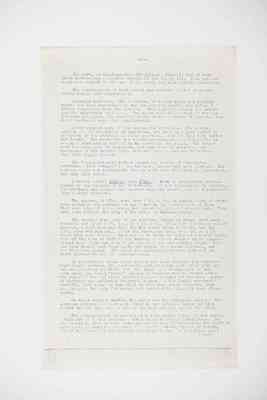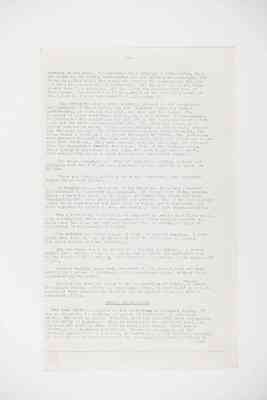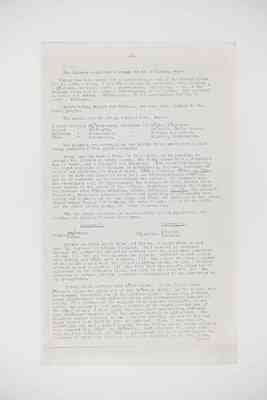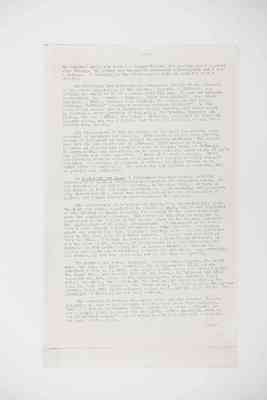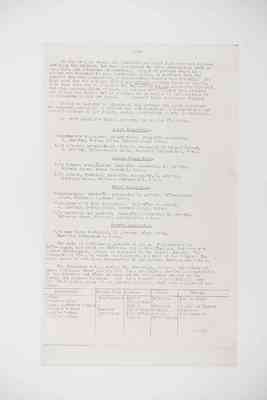Pages
16
-13-
The yuru, or climbing-vine (Flagellaria Indica), was of very great service and a regular article of the family kit. Both men and women were expert in the use of it, which has been already described.
The construction of bark canoes was understood, but they were rarely called into requisition.
Utensils were few. The coolaman, or wooden basin for holding water, had been superseded by the tin can for general use before I became acquainted with the natives. They employed stones for grinding the bunya-nuts into meal. The women made dillie-bags of various patterns and sizes, the material being grass or string of squirrel fur. Small hand-nets were also manufactured.
Their weapons were of few and simple varieties. The kuthar, usually called nullanulla by Europeans, was used as a club either to be thrown or for striking at close quarters. With it they both hunted and fought. The heavy end was sometimes rendered more formidable by having a surrounding band of knobs carved in the solid. The kuthar were commonly made of iron-bark, but many were brigalow, and specimens of the scented myal, obtained from a distance by barter, were very highly prized.
The boomerangs were narrow, light and devoid of ornamental carvings. Some returned to the thrower, others only sped forward. The natives could not distnguish the one sort from the other by inspection, but only upon trial.
A weapon called bokkan, from bokka, a horn or projection, corresponded to the leangil of the Victorians. It was rectangular in outline, the striking end pointed and shorter than the handle, and it was wielded like a light pick-axe.
The spears, or koni, were from 7 to 10 ft. in length, made of ironbark spalings and hardened at the point by the application of fire. They were usually quite plain, but occasionally had a single barb. They were cast without the help of the lever or throwing-stick.
The shields were only of one pattern, oblong in shape, with ends rounded, and about 2 ft. long by 1 ft. wide. They were sometimes called helemon, a word borrowed from the New South Wales dialects, but the local name was kunmarim, after the currajong tree, from the wood of which they were formed. They had to be thick to allow of a handle being made at the back by cutting and burning a hollow under a short longitudinal bar. Although very light the wood was exceedingly tough. Some old ones showed many deep dents and prints from blows received, and yet they were sound. The front was generally coloured with red and white pigment by way or ornamentation.
In prehistoric tiimes stone knives had been utilised for hand-tohand single combats, the combatants each clasping each other with one arm and striking the knife into the thigh or a fleshy part of the back until one cried "Hold." Pieces of butcher knives, hafted after the style of the old stone knives, came to be used for the same manner of fighting and inflicted frightful gashes. A boy Donald received a terrible, deep wound in his thigh in this way, which festered, kept him lying in the camp for weeks, and rendered him lame for long afterwards.
In their regular warafare the spear was the offensive weapon. The warriors advanced, to meet each other in two extended lines and they fought two and two, ie., a man on one side engaged one on the other.
The message-stick in use was of a very simple form. It was merely a tiny bit of a twig bearing a few notches by way of inscription. On one occasion, when we were resuming our journey after passing the night at Gigoogan, [my?] blackboy produced a piece of a stick, 1 1/2 in. in length, out of the lining of his hat and showed it to me. It had three small
(over)
17
-14-
notches on one side. He explained that this was a love-letter, that the notch in the middle, represented him the Dhomka, or messenger, and those on either side, the young man sending the message and the girl for whom it was intended respectively. The two had met at the bunya season some time previous, and the lover was renewing his vows by this means. The letter had to be carried in the hat for a month or two before he had an opportunity of delivering it.
The corroboree was a very essential element in the occupation and pastimes of the natives. In its elaborate forms for public performance, it combined the play, the song and the dance. The composer of a new corroboree was regarded as a person of consequence. He instructed the performers and led off in the representations before both his own tribe an its neighbours. The music was generally a rather mootonous chant, often rising suddenly an octave while preserving the same melody. The grand corroborees were given at night, the stage being a level plot of ground illumined by fires. The performers were painted fantastically with red and white clay, and sometimes decorated with feathers. They were usually disposed in ranks, and advanced from the background towards the fires. Part of the dancing motion was a peculiar quivering of the legs, the feet being spread apart. This peculiarity seems to have been common throughout Australia.
The women assisted as a kind of orchestra,, sitting in front and clapping with their hands upon stretched possum skin or on their own thighs.
There was often a little plot in the corroboree, the machinery being always very simple.
At Monsildale, a tributary of the Brisbane, there was a carved log intended to represent an eaglehawk. It formed part of the accessories of what was known as the Eaglehawk Corroboree, which had been transmitted from some place distant and unknown. One of the interesting facts about corroborees was that they travelled great distances, and were repeated by tribes to whom the words of them were unintelligible.
The corroborees, composed to be rendered in public on a large scale, with dancing and other accompaniments, were often sung in private to while away the hour, the singers keeping time by striking a pair of boomerangs or nulla-nulla together.
The natives had their canons of taste as regards singing. I have heard them take off one another very well in the matter of tremolo and other faults of tone production.
The one theme would be varied from andante to allegro. A common signal for a change of time or melody was to trill one sustained note to the sound of the letter r. This answered the purpose of the ringing of a bell.
Popular English songs were transformed into corroborees and sung lustily by a group of blackboys, after corroboree style, without their comprehending the sense.
The natives were all given to the composition of little stories or lyrics on passing events, efforts in occasional verse, as they might be called. Sometimes they mixed up the English and aboriginal languages with a ludicrous effect.
SOCIAL ORGANISATION
The term tribe as applied to the aborigines is somewhat vague. It has no reference to numbers, or extent of territory, or political unity. The bond of tribal affinity, that has generally been recognised, is community of language. This is invariably the strongest bond, and involves and implies other factors making for union. There was no chieftain, no organised government. There are no chiefs, in the ordinary application of the word, in Australia. A few families claiming the same territory usually camped and travelled together, sometimes in
(over)
18
-16-
The classes regulated marriage in the following way:-
Taking the Kabi tribe for illustration, a man of the Barang class had to marry a woman of the Bonda class, if available, but, failing a Gandagan, he could marry a Dherwaingan. Similarly, a man of the Balkuin class had to marry a Dherwaingan, if available; but provided he could not obtain a Dherwaingan, it was permissible for him to marry a Bondagan.
Substituting Banjur for Balkuin, the same rule applies to the Wakka people.
The system may be put in tabular form, thus:-
Balkuin marries Dherwain-gan, children are Bonda, Bonda-gan. Barang marries Bonda-gan, children are Dherwain, Dherwain-gan. Dherwain marries Baljuin-gan, children are Baran, Barang-gan. Bonda marries Barang-gan, children are Balkuin, Balkuin-gan.
The classes are arranged in two pairs, those which form a pair being prohibited from inter-marrying.
Going only by such a table as that above, it is possible to arrange the classes in wrong pairs. The table shows that a Balkuin's son is Bonda, and a Barang's son Dherwain. With imperfect knowledge, one might conclude that descent is patrilincal, because, thinking of father and children, it runs Balkuin, Bonda, Balkuin, Bonda, ad lib., and so on with the other classes that are correspondingly related. But so to conclude is to misapprehend the system. The correct way, the aboriginal way, of apprehending the descent in these tribes is to have regard to the class of the mother. Reckoning through the mother the descent runs Bonda, Dherwain, Bonda, Derwain, ad lib., The classes, therefore, that were paired together and forbidden to intermarry were Barang and Balkuin, on the one hand, and Bonda and Dherwain on the other. Substituting Banjur for Balkuin, the same remark applied to the Wakka and the other tribes having the Wakka class-names.
The two large [moieties?] are conveniently called phratries. The classes are divided beween them thus,
Phratry I. Dilbai: Dherwain & Bonda
Phratry II. Kopaitthin: Barang & Balkuin
Dilbai is often spelt Dilbi and Dilebi, methods which do not make the terminal diphthong distinct. That descent is reckoned through the mother is absolutely certain from the following considerations: (1) the way the classes are paired: Dherwain is not paired with Barang nor Bonda with Balkuin, (2) the option to marry a member of the class paired with the proper marrying class, in case a regular partner is not available (3) the fact that the child's class has no reference to the father's class, but only to the mother's (4) the division of nature into two sections corresponding to the phratries in my arrangement.
Barang class married with Bonda class; if the female were [Bendagan?] class the child was of the Dherwain class; if the female were Barang-gan, the child was of the Balkuin class. Similarly, Balkuin class intermarried with Dherwain class with corresponding descent of names. If a partner of the regular class was not available, it was lawful and common to mate with a member of the right phratry but of the other class. I have given the most exact information obtained from different sources as to the proper classes to intermarry. The children always belonged to the mother's phratry, and not to her own class paired with hers to form the phratry. Thus, I knew two men, [Nurudhalin] and [Bual], both belonging to the Barang class, whose children were respectively Bonda and Dherwain. Why? Because the wives were respectively Dherwain and Bonda. If descent had been partrilineal the children of these two families would have belonged to the one class. (over)
19
-17-
My maternal uncle was called a Barang because the leading local natives were Barang. My mother was therefore accounted a Barang-gan and I was a Balduin. I belonged to the class paired with my mother's in her phratry.
The following two facts supply incidental proofs of the accuracy of the above explanation of the system. [Kagariu], a Dherwain, was getting the worst of it in a tussle with his gin. He saw two natives approaching, one [Waruin], a Balkuin, oder than himself; the other, [Turandiu], a Bonda, younger than himself. He called out for help, "Wuthung, Wuthung!" (Younger brother, younger brother!") to the younger and weaker man as belonging to his phratry, the other would be counted a tribal brother of his wife. Two youths, [Turandiu] and [Kilkoi], the one a Bonda, the other a Dherwain, attempted to force an elderly woman, who was a Barang, and therefore belonged to the other phratry from theirs.
All the members of the one class, of the same generation, were reckoned as brothers and sisters. Even members of the same phratry, though of different classes, called themselves brothers. The classname was the commonest mode of address. They seemed to take a pleasure in calling one an other Barang or Banjur, Bonda or Dherwain. To marry within the one class, or to marry into the other class of one's own phratry was alike unlawful. I knew of no such marriage. Still cohabitation between members of classes not allowed to marry was not regarded, apparently, so heinous an offence in these tribes as in other parts of Australia. The union was not allowed to continue, but no penalty was inflicted.
In Eaglehawk and Crow, I propounded the hypothesis, that the intermarrying classes originally represented two different races. On the occasion of my visit to Barambah, in October 1906, a station on the border of Kabi and Wakka territories, I accidentally and unexpectedly discovered that these two tribes recognised the distinction of lighter and darker blood as characterising the classes.
The distinction as to the colour of blood, has, theoretically, among the Kabi and Wakka, a relation to colour of skin, and is not confinded to the classes in human society, but extends to the animals grouped with the respective classes. The colour of the skin is supposed to correspond to the colour of the blood. Such is the theory, although the application of this seems inconsistent. It is important to note a fact I have already called attention to, viz., that the two classes which are paired together, forming a phratry, have a common relationship to the same sets of natural objects. I cannot say for certain that the whole of Nature is subjected to a dichotomous division, as was the case at [Mt. Gambier], in South Australia, and also among the Euahlayi in New Sougth Wales, but an immense number of objects in heaven and earth are distributed between the phratries, and, probably, all Nature, if not now allocated, was at one time so divided.
To Balkuin and Barang belonged, amongst other objects, the north wind, the emu, the white cockatoo, the carpet-snake, kīlla (darkcoloured native bee), dinda (the magpie lark), coal, red clay or paint, the bunya tree, the Moreton Bay ash and grass. To Dherwain and Bonda belonged the sun, moon, starts, clouds, night, wind, thunder, light water, the whale, the eaglehawk, the curlew, the black cockatoo, the dog, the "old man" kangaroo, the brown snake, the dark goanna, the ground goanna, kawai (the light-coloured native bee), and the deaf adder. The principle of division is far from obvious.
The connection between the human being and the natural objects belonging to his or her phratry, was regarded to be very intimate. Thus if a Barang or Balkuin wanted information about a friend, and saw a magpie lark, he would ask the little bird a question, such as "Is my brother coming?" and it would be its note give him a suitable and intelligible reply. (over)
20
-18-
So far as I am aware, the restrictions about food were not dependent upon the classes, but were determined by other principles, such as age, sex, and occasions of mourning. Groups of persons stood in a common relationship to some particular totem, as distinct from the general phratric connection, a relationship derived hereditarily. The Kabi word for the totemic animal was murang, meaning flesh or animal. With this word may be compared the Bugandaity tuman, similarly employed and also meaning flesh or meat. A man was not debarred from killing and eating his totem, but in practice he protected it and regarded it as belonging to his own people. A person's totem was never changed.
It may be helpful to illustrate the phratry and class relations by concrete examples. I subjoin the relationship of [Tanggauwanan] and several members of her family, giving particulars as far as available.
D. will stand for Dilbai phratry, and K. for Kopaitthin.
First Generation.
[Tangguuwannan]'s maternal grandfather; Dauwabora community, K. phratry, Barang class, Nguruin (emu) totem.
T.'s maternal grandmother; Patyala community of [Frazer Island], D. phratry, Dherwain-gan class, Muroirai (whipsnake), totem.
Second Generation.
T.'s father, [Wanggūmbalu]; Gundabora community, K. phratry, Balkuin class, Koroi (possum), totem.
T.'s mother, [Bondobin], Dunwabora community, D. phratry, Bondagan class, Muroirai (whipsnake), totem.
Third Generation.
[Tanggauwanan]; Gundabora community, D. phratry, Dherwain-gen class, Muroirai (possum) totem.
[Yanbirinya] (T's Kabi betrothed); Gigarbora community, K. Phratry, Barang class, Nguruin (emu), totem.
T.'s bothers and sisters; Gundabora community, D. phratry, Dherwain class, Muroirrai (whipsnake), totem.
Fourth Generation.
T.'s son (born Victoria), D. phratry, bonda class, Muroirai (whipsnake), totem.
The rule of matrilineal descent is clear. [Tanggauwanan] is Dherwaingan, her brothers Dherwain, her mother Bondagan, her mother's mother Dherwaingan. These all belonged to the Dilbai phratry. The community or bora, to which one belonged, was that of the father. The totem seems to have been transmitted by inheritance through the mother.
The following table, giving the phratries, classes, and totems of three families, shows clearly (1) that the Dilbai phratry is constituted by the Dherwain and Bonda classes and the Kopaitthin phratry by the Barang and Balkuin classes; (2) that descent is matrilineal; and (3) that either class of one phratry may marry with either class of the other.
| Individual | Native Name | Section | Class | Murang |
|---|---|---|---|---|
| [Arthur] | [Bujirgundau] | Dilbai | Dherwain | Emu or Bunya |
| [Arthur]'s wife | ? | Kopaitthin | ? | ? |
| [Peggy], [Arthur]'s mother | ? | Dilbai | Gondgan | Goanna or Turkey |
| [Arthur]'s father | [Munojan] | Kopaitthin | Balkuin | Kangaroo |
| [Peggy]'s father | [Kuneraman] | Kopaitthin | Barang | Carpet-snake |
| [Peggy]'s mother | ? | Dilbai | Dherwaingan | ? |
